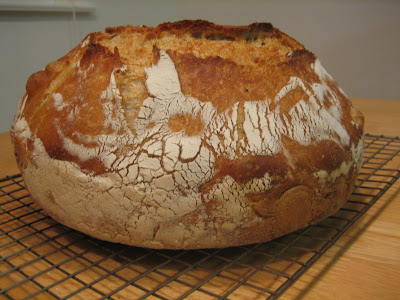
Make this recipe just once and you'll find there's nothing needless about this bread.
3 cups all-purpose or bread flour, more for dusting
¼ teaspoon instant yeast (not rapid-rise)
1 1/2 teaspoons salt
1 1/3 (to 1 1/2) cups water
Cornmeal or wheat bran as needed.
1. In a large bowl combine flour, yeast and salt. Mix thoroughly. Add 1 1/3 cups water, and stir until blended; dough will be shaggy and sticky. Cover bowl with plastic wrap (not sealed airtight). Let dough rest at least 12 hours, preferably about 18, at warm room temperature, about 70 degrees.
2. Dough is ready when its surface is dotted with bubbles. Lightly flour a work surface and place dough on it; sprinkle it with a little more flour and fold it over on itself once or twice. Cover loosely with plastic wrap and let rest about 15 minutes. (This step is somewhat optional, I often skip it.)
3. Using just enough flour to keep dough from sticking to work surface or to your fingers, gently and quickly shape dough into a ball. Generously coat a cotton towel (not terry cloth) with flour, wheat bran or cornmeal; put dough seam side down on towel and dust with more flour, bran or cornmeal. Cover with another cotton towel and let rise for about 2-4 hours. When it is ready, dough will be more than double in size and will not readily spring back when poked with a finger.
Another easier option for rising, is to flour a large piece of parchment paper, place the dough ball on it, then cover with a floured towel, plastic wrap, or even an inverted glass bowl so you can watch it.
4. At least a half-hour before dough is ready, heat oven to 450 degrees. Put a 6- to 8-quart heavy covered pot (cast iron, enamel, Pyrex or ceramic) in oven as it heats. When dough is ready, carefully remove pot from oven. Slide your hand under towel and turn dough over into pot, seam side up; it may look like a mess, but that is O.K. Shake pan once or twice if dough is unevenly distributed; it will straighten out as it bakes.
If you used the parchment paper option, just uncover it and pick the whole thing up like a sling, and lay it in the pot.
5. Cover with lid and bake 30 minutes, then remove lid and bake another 15 to 20 minutes, until loaf is beautifully browned. Cool thoroughly on a rack. If you don't let it cool, it will be gummy and gooey.
Yield: One 1½-pound loaf.
Time: About 1½ hours plus 14 to 20 hours’ rising
Adapted from Jim Lahey, Sullivan Street Bakery (from New York Times, also see this article)
This bread is easily modified. Try 1 to 1-1/2 cups whole wheat or rye flour instead of all white. Toss in 1/4 to 1/2 cup of sunflower seeds. One I do a lot is 1/2 cup whole wheat (2-1/2 cups white) plus 1/2 cup chopped walnuts and 1/2 cup dried cranberries. Sometimes I also throw in some orange zest and ground cardamom.
Sprinkling some caraway/sesame/poppy seeds on top is nice. You can also slash the top with a sharp knife or razor to make nice designs and avoid splitting on the sides.
I also do sourdough a lot. I keep a starter I grew from scratch in the fridge and just feed it a little every now and then. Just leave out the yeast and mix 1/2 cup of starter into the water. Usually sourdough is very wet dough, if you're going to do a free-form dough ball on parchment paper, only use about 1-1/4 cups of water or it will spread out too much. Or leave it wet and rise (proof) in a bowl for fluffier bread.
There are so many other possibilities out there, I've only started to scratch the surface. Look on www.breadtopia.com and www.thefreshloaf.com or Google "no knead bread".
Some day I'll add a post about how we use no-knead to make great pizza dough.

3 comments:
Oh. Em. Gee. This bread is incredible. Make this recipe now and it will change your life. I mean it.
The bread is in the oven, and I can feel my life changing already. There was a brief skirmish in regard to the wording of the instructions (which I know you did not actually compose). Michael wants- no, needs to know if the half-hour timing of the preheating baking vessel begins when the oven is up to 450 degrees, or as soon as the oven is turned on.
Meanwhile, Myoko and I are salivating.
Well, your oven's heating time will be slowed by the vessel's presence, no? I mean, your oven won't think it's 450 until that vessel is damn hot, so I think the timing can probably start when you turn the oven on; your oven will be preheated in, say, 10 minutes or so, then your vessel still has 20 minutes to become proper temp. I think also that it's not a science and whatever Michael thinks is right is, obviously, right.
Our flame-colored Le Creuset that Jeffrey and Myoko gave us turned a beautiful dark red/orange when it was up to temperature. Fun!
Post a Comment